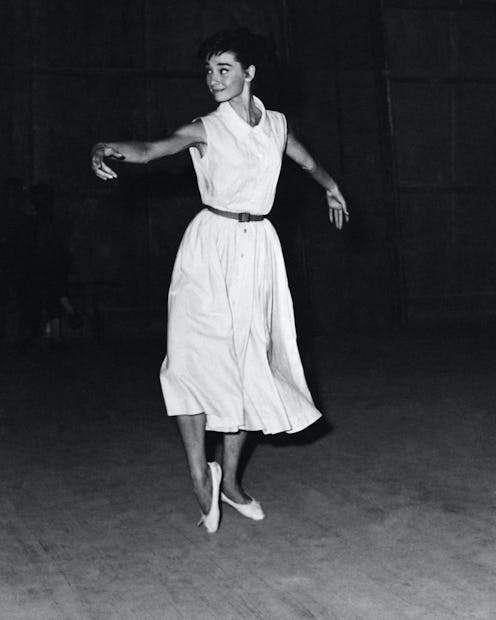(Trends)
The History Of Ballet Flats & Why They’re Always Evolving
From Brigitte Bardot to Prada’s iconic punk pair.

In 1956, Brigitte Bardot had a small request that would forever shape the history of ballet flats. She tapped Rose Repetto to create the Cendrillon Ballerinas — a pair of ballet slippers that were intended not for the stage, but for the city; everyday life made subtly chicer. Since then, this classic shoe has morphed and evolved to become among the most cherished wardrobe staples for ballerinas and non-dancers alike. And despite the fact that its core design details are quite simple, the ballet flat remains a key style for fashion editors, stylists, and brands who imagine fresh ways to wear and design the shoe decade after decade.
Though Bardot led the charge in popularizing the ballet flat, its origins date back much further, of course. Dancers have been wearing some iteration of this unique slipper for centuries before it transitioned to everyday wear. In 1941, designer Claire McCardell introduced the Capezio long sole ballet shoe into her collection, which elicited a positive response from retailers at the time, like Lord & Taylor and Neiman Marcus and publications like Vogue, which featured the Capezio ballet flats on its cover in 1949. But, while you may hold on to classic takes on the flat (Chanel’s two-tone style remains a staple for a reason), the shoe has also evolved over time. Today, quirky details and artistic flourishes have brought this shoe back into the fashion cycle anew. Below, find the modern takes on the ballet flat that make it a shoe worth wearing in 2022.
We at TZR only include products that have been independently selected by our editors. We may receive a portion of sales if you purchase a product through a link in this article.
Classic Romanticism
When Bardot described the ballet flat she wanted Repetto to create, her requirements were simple: a shoe that was delicate and effortless to slide into (like a ballet slipper) but also sensible for everyday wear. This manifested as a rounded-toe slipper with a small bow upfront and a décolleté shape that reveals the foot. For many, this silhouette is considered the most classic ballet flat version of them all, which is why style icons like Bardot and Audrey Hepburn often come to mind when thinking of this timeless slipper. "Beyond their versatility, ballet flats have stayed a true classic because there’s an air of romanticism about them," THE YES Creative and Fashion Director Taylor Tomasi Hill tells TZR. "You see ballet flats and you think dancers, Audrey Hepburn in Roman Holiday, super chic Parisians…it’s not just a style, but an attitude, too."
Subversive Side
For Tomasi Hill, there’s nothing more interesting than taking a classic and subverting it a little. During the Spring/Summer 2016 runway season, Miu Miu achieved just that. "Miuccia Prada changed the game," Tomasi Hill says. "Her buckled flatform for Miu Miu with the wraparound, checkered ribbon straps — talk about subversion! They found a way to make the ballet feel a touch punk." Though it’s been years since the Miu Miu take first debuted, it remains an iconic twist on the classic footwear choice.
Toe-Tally Fresh
Another fresh take on the ballet flat that's picked up speed as of late is reworking the toe silhouette. "I’m really loving the pared-down, minimalist options from Khaite and Mansur Gavriel with a strong, square toe," Tomasi Hill says. "The angles and corners add a little [architectural] touch."
Modern Functionality
Newly-launched footwear label Yuni Buffa introduced its iteration of the ballet flat, Pia, inspired by functionality. "The design for our Pia Ballet Flat was inspired when I saw a ballerina customizing her pointe shoe to fit her perfectly," Buffa shares. "She would cinch and tie the cord to make the throat of the shoe fit her, hit it against the bar to make the sole softer, and make little cuts on the outsole for better friction." Buffa explains that she wanted to design an elegant ballet flat with a functional cinch-cord instead of a decorative one. "In my design process, I obsess over the fit; functional elastic cinch cords will often dig into the back of the heel, so we carefully reinforced the back seam but without making it hard," she shares. "We also included a discreet leather heel and soft insole since wearing flats can tire your feet out." Yuni Buffa's ballet flat also has one distinguishing factor: the square toe, a mainstay from seasons past. "We continuously re-worked our wooden last until we hit this beautiful, elongated soft square toe with a slim profile," she says. "Together with the superior soft unlined Nappa leather, Pia really lives up to its ballerina heritage."
A Blank Canvas
As preferences ebb and flow, so will ballet flats. “Ballet flats are an iconic reference and the simplicity of their style offers a blank canvas that can be inspiring and invite re-imagination,” Buffa says. By the same token, Tomasi Hill agrees with this blank canvas sentiment. “Not only for designers but also in terms of styling. Cropped denim, wide trousers, tulle skirts, day dresses — they work with everything,” she says. “They’re a go-to when you’re packing or building a wardrobe of staples. That sort of freedom and flexibility will never go out of style.”
This article was originally published on